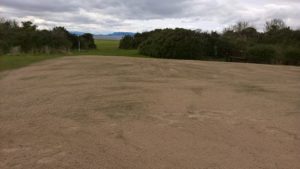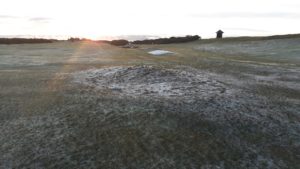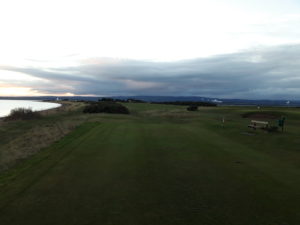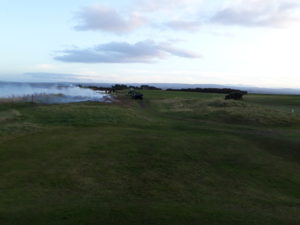March 19th

That’s us back onto the summer course with preferred lies on the fairways back in operation. Thank you to the members who have used their mats throughout the winter months which has helped reduce the level of damage to the semi roughs. The level of play the course has received this winter has been quite exceptional apart from the week of rest in early February from the snow fall and it was great to see all the kids out enjoying some sledging at the 17th.
Minus temperatures since the start of January up until Mid February and this combined with staff furloughs meant some of our bunker repair work didn’t get completed. The ones we have revetted are back in play now. We have cut some more whin bushes down at the 13th and taken them away at the right of the 18th green which has been seeded this week. GUR for a while here.
Work on the greens has seen an application of Iron and magnesium followed by a double verti-cut to remove some moss which is quite prevalent this year. An initial sanding and pencil tine to 6″ deep was done early March and another sand dressing and a spring fertiliser will go on next week. Just for comparison we have only cut the greens four times this year with very little grass coming off compared to five times last January alone. We are still cutting at 5.5mm and this will come down slowly as sand is incorporated and any holes and imperfections fill in.
The summer tees have been scarified to 1″ deep and heavily sanded which is aimed at reducing some of the softer growth, invigorating some new growth  and firming the surfaces up. An Iron and Ammonia spray has gone on last week and a granular feed and wetting agent is planned next.
and firming the surfaces up. An Iron and Ammonia spray has gone on last week and a granular feed and wetting agent is planned next.
Our fairways have also been sprayed with Iron and Ammonia to deter the moss and stimulate a little spring growth and boost colour. We have sanded the approaches and green surrounds to aid a little recovery from footfall. I would like to do most of the fairways but cost is a limiting factor with a 20 tonne load of sand costing £600! Leatherjackets are going to be a big concern this year not just from birds overturning divots but the effect the grubs have on the grass plants root system. A nibbled and shortened root will die much quicker under stress from heat or dry weather and last years Autumn plague on the fairways is a very bad sign. We have a wetting agent ready to go on when the next spell of soft weather comes along. This will help water be drawn through the turf and bind onto soil particles which in turn enables the soil to re hydrate during times of rainfall.
 The range got its first cut this week and is looking great. The downside is that it took almost 2 hours to rake up all the divots and collect golf balls before it could get cut. This is time we can ill afford with a small team of four greenstaff. It would help us greatly if the mats provided could be used or if hitting from the grass then a couple of minutes spent replacing your divots after would be greatly appreciated. Can I remind also that no iron play from behind the main mat and please do not leave divots sprayed over any of the small greens on the range. Thank you.
The range got its first cut this week and is looking great. The downside is that it took almost 2 hours to rake up all the divots and collect golf balls before it could get cut. This is time we can ill afford with a small team of four greenstaff. It would help us greatly if the mats provided could be used or if hitting from the grass then a couple of minutes spent replacing your divots after would be greatly appreciated. Can I remind also that no iron play from behind the main mat and please do not leave divots sprayed over any of the small greens on the range. Thank you.
Our long roughs have been cut and collected last week and this helps reduce the nutrient going back into the soil which favours ranker grass such as Yorkshire Fog and Rye grass. We annually spray with a herbicide now which will selectively treat these courser grasses with a view to encouraging the finer Bents and Fescues. When the longer roughs mature into full seed it is such a lovely sight (and hazard!) although could we ask any buggy users to draw up alongside and walk into the rough to find their ball.
With the season about to stutter to a start and having no bunker rakes out yet it would be nice for everyone who goes into a bunker to smooth the sand over with the sole of your shoe. Remembering a lift and place within 6″ is still in place until rakes are returned for use.
Volunteer work – if any of our members who have some spare time would like to give the course a hand it would be greatly appreciated. We have a list of jobs from divot collecting and filling, litter picking and various painting jobs. Contact myself or Mike for info. Following on from last years successful members divotting evenings we would like to do this again and dates will follow. Thank you to all who give up their time.
George Paterson – Head Greenkeeper
07808 202050 or (sheds) 01381 622323




 Micro hollow tining is planned for around mid February. Fairways and greens surrounds have also been slit with some fairways receiving a sanding also. In November we sprayed Iron to all areas apart from the longer roughs in our combat against moss and this will be done again in the spring along with some Ammonia (Nitrogen) and wetting agent.
Micro hollow tining is planned for around mid February. Fairways and greens surrounds have also been slit with some fairways receiving a sanding also. In November we sprayed Iron to all areas apart from the longer roughs in our combat against moss and this will be done again in the spring along with some Ammonia (Nitrogen) and wetting agent. Up turned turf is used in the bases to both provide a firm base and also to keep stones from coming through. These will be topped up with sand around early March and brought into play for the first competitions. Proposal – The twin bunkers on the 15th fairway have been earmarked for a redesign into one large bunker. Back in the early 90s this was to be the case but while digging out the bunker we came across the irrigation pipe and had to split the bunker into two. The new irrigation line now runs past the right hand side of the bunkers therefore allowing these bunkers to be improved and made into something more aesthetically pleasing.
Up turned turf is used in the bases to both provide a firm base and also to keep stones from coming through. These will be topped up with sand around early March and brought into play for the first competitions. Proposal – The twin bunkers on the 15th fairway have been earmarked for a redesign into one large bunker. Back in the early 90s this was to be the case but while digging out the bunker we came across the irrigation pipe and had to split the bunker into two. The new irrigation line now runs past the right hand side of the bunkers therefore allowing these bunkers to be improved and made into something more aesthetically pleasing. The large obtrusive section of gorse has been removed to open up the fairway view from the tee. The natural sand base has been exposed to create an in play sand scrape and this will both help speed up play and allow you to see where your ball goes.
The large obtrusive section of gorse has been removed to open up the fairway view from the tee. The natural sand base has been exposed to create an in play sand scrape and this will both help speed up play and allow you to see where your ball goes.






 The tees have also been verti-drained and next to do will be the approaches.
The tees have also been verti-drained and next to do will be the approaches. Both greenside bunkers at the 7th have been newly revetted and the front greenside at the 11th is underway. We have highlighted around 9 greenside bunkers to do this year and will be GUR until around mid March.
Both greenside bunkers at the 7th have been newly revetted and the front greenside at the 11th is underway. We have highlighted around 9 greenside bunkers to do this year and will be GUR until around mid March.





 All 90mm MDPE ring main pipe and 63mm going to the greens and tees were vibratory mole ploughed into the ground to 600mm deep. The soil underneath is very stoney to say the least and several sections of the old original 1″ steel irrigation line got unearthed. During March all the 50mm pipe and Valve in head sprinklers were installed around the greens and positioned a little further out so that the aprons can receive irrigation also. Recently the tees sprinklers have been going in and all our old greens sprinklers have been re used to save some money. These are being set in down either side of the tees to allow accurate watering of the tees themselves and also taking account of heavily walked areas by the tees. At this date there are still 5 tees and the lower putting green to complete, the new tank to erect and a new variable speed pump to go into the pumphouse. All going well once electrical and softwear work is tested, the pipe lines and sprinklers flushed and primed we are looking at around a mid April completion.
All 90mm MDPE ring main pipe and 63mm going to the greens and tees were vibratory mole ploughed into the ground to 600mm deep. The soil underneath is very stoney to say the least and several sections of the old original 1″ steel irrigation line got unearthed. During March all the 50mm pipe and Valve in head sprinklers were installed around the greens and positioned a little further out so that the aprons can receive irrigation also. Recently the tees sprinklers have been going in and all our old greens sprinklers have been re used to save some money. These are being set in down either side of the tees to allow accurate watering of the tees themselves and also taking account of heavily walked areas by the tees. At this date there are still 5 tees and the lower putting green to complete, the new tank to erect and a new variable speed pump to go into the pumphouse. All going well once electrical and softwear work is tested, the pipe lines and sprinklers flushed and primed we are looking at around a mid April completion.









